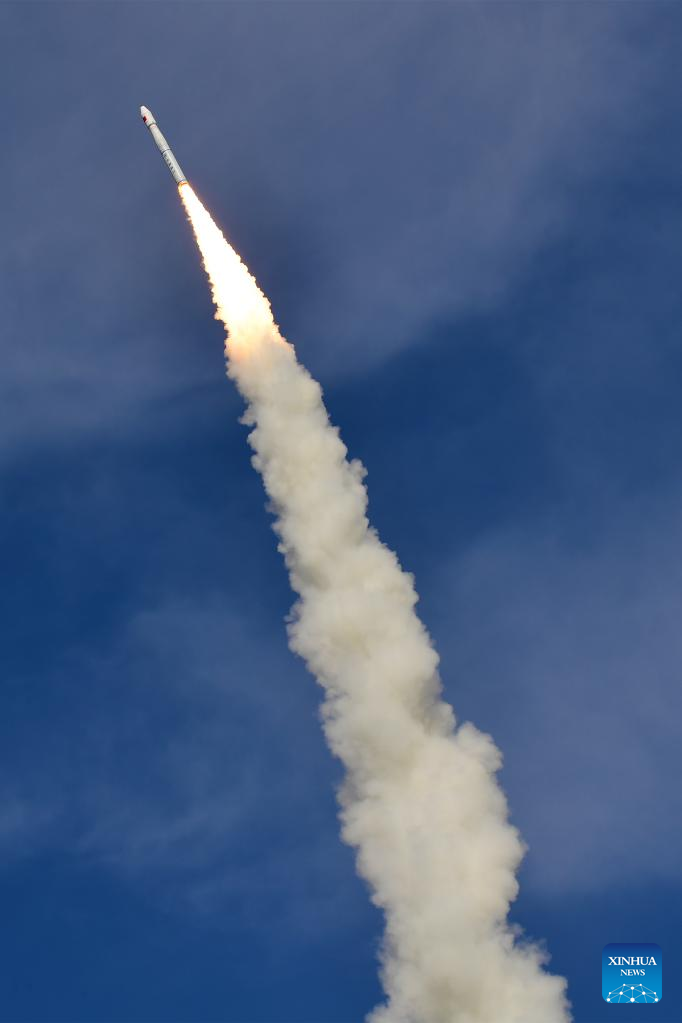30.03.2022

HELSINKI — China launched its first Long March 6A from a new launch complex at Taiyuan Tuesday, successfully sending two satellites into sun-synchronous orbits.
The 50-meter-long, 530-metric-ton Long March 6A lifted off from the Taiyuan Satellite Launch Center at 5:50 a.m. Eastern March 29. The rocket features two kerosene-liquid oxygen stages and four solid propellant side boosters.
The Shanghai Academy of Spaceflight Technology (SAST), the rocket maker and subordinate to China’s main space contractor, CASC, declared success of the mission within half an hour of launch.
Two satellites were placed into sun-synchronous orbit (SSO). The Pujiang-2 satellite was developed by SAST for “scientific experimental research, land and resources census and other tasks.” Pujiang-1, launched on the first Long March 11 in 2015, was also developed by SAST and dedicated promoting “smart city” construction, according to Chinese reports.
Tiankun-2 satellite was developed by the Space Engineering Group under the second academy of the China Aerospace Science and Industry Corporation (CASIC) for “experimental verification of space environment detection technology.” CASIC’s second academy focuses on air and space defense systems.
Tiankun-1, launched by CASIC’s Kaituozhe-2 rocket in 2017, was stated to test the performance of a small satellite bus. CASIC’s Space Engineering Group states that the new satellite inherits the “high functional density” of the earlier satellite while also being smaller and lower in cost and will verify new attitude and orbit control algorithms, multi-functional flexible cladding materials and computational optical imaging.
The launch is the latest in a line of new generation launch vehicles since 2015, this time combining both new Chinese kerosene-liquid oxygen and solid propellant capabilities. Numerous launch systems elsewhere, such as the Space Shuttle and Ariane rockets, have long used solid rocket boosters.
The Long March 6A launched was facilitated by a new launch complex constructed specifically for the new rocket at Taiyuan, north China. The new facility allows for more automated processes, such as fueling, and shorter launch preparations lasting 14 days. Images of the site also suggests a water deluge system to alleviate damage for high temperatures and cushion against acoustic vibrations.
The new, 3.35-meter-diameter rocket bears little resemblance to the 2.25-meter-diameter Long March 6. The much larger 6A uses two YF-100 kerolox uses on its first stage can lift four tons to a 700-kilometer SSO, compared with up to 1,000 kilograms for the 29-meter-long Long March 6 which uses a single YF-100.
The 6A is also expected to be available in variants with two boosters or none at all.
The 6A fills a narrow gap in launch capabilities to SSO while also providing a new and differentiated alternative. Figures published by CASC show that the much lighter Long March 8 (360 tons) and its single core variant (200 tons), developed by the China Academy of Launch Vehicle Technology (CALT), can loft 5 and 3 tons to a 700-kilometer SSO respectively, launching from the coastal Wenchang launch center.
SAST states that the development and launch of the rocket demonstrated breakthroughs in combining liquid and solid propellant stages and related separation and gimbaling technologies. It also allows for a wide payload fairings of 4.2 and 5.2 meters.
CASC has also recently developed much larger, 3.2 and 3.5-meter-diamater solid rocket engines which it says could be used with heavy lift rockets for lunar and deep space missions. Its planned largest rocket, the Long March 9, does not appear to include solid boosters in its various designs, however.
The country has also been developing a range of solid propellant launchers to meet growing launch demands and contribute to a wider strategy of making China a fully-fledged space power.
The launch was CASC’s and China’s seventh of 2022, with CASC aiming to launch at least 140 spacecraft across more than 50 launches this year alone, including six missions to complete its modular space station. Commercial launch providers are expected to add to China’s launch activities.
Quelle: SN
+++
China launches three satellites

A Long March-11 carrier rocket carrying three satellites blasts off from the Jiuquan Satellite Launch Center in northwest China, March 30, 2022. China has successfully sent three satellites into space from the Jiuquan Satellite Launch Center in northwest China on Wednesday. The three satellites Tianping-2A, Tianping-2B and Tianping-2C will provide services such as atmospheric space environment survey and orbital prediction model correction. (Photo by Wang Jiangbo/Xinhua)
China has successfully sent three satellites into space from the Jiuquan Satellite Launch Center in northwest China on Wednesday.
The three satellites were launched by a Long March-11 carrier rocket at 10:29 a.m. (Beijing Time) and have entered their planned orbit.
The three satellites Tianping-2A, Tianping-2B and Tianping-2C will provide services such as atmospheric space environment survey and orbital prediction model correction.
It was the 413th mission of the Long March rocket series.

A Long March-11 carrier rocket carrying three satellites blasts off from the Jiuquan Satellite Launch Center in northwest China, March 30, 2022. China has successfully sent three satellites into space from the Jiuquan Satellite Launch Center in northwest China on Wednesday. The three satellites Tianping-2A, Tianping-2B and Tianping-2C will provide services such as atmospheric space environment survey and orbital prediction model correction. (Photo by Wang Jiangbo/Xinhua)
Quelle: Xinhua
